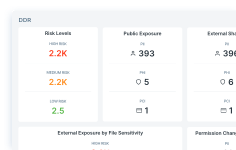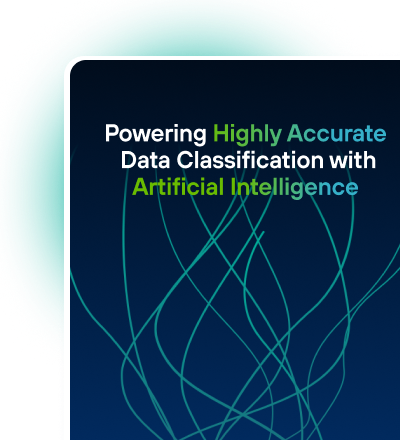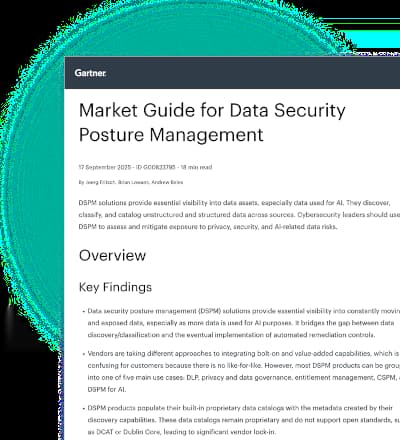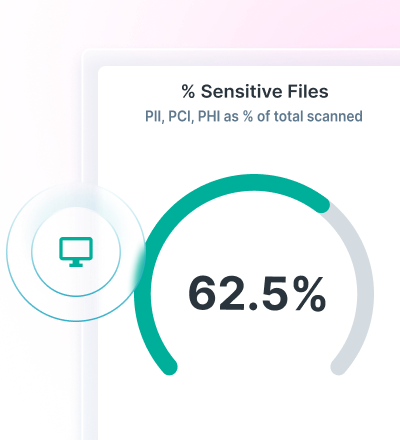Data Risk Assessment: The Complete Guide (Includes Free Forcepoint DRA)
0 min read

Lionel Menchaca
In today’s enterprise landscape, data is fluid. It travels across SaaS apps, hybrid clouds, personal devices, and unmanaged file shares. For security and data leaders, this has created a fundamental challenge: How do you protect what you can’t see?
The stakes are high. IBM’s 2024 report pegs the average cost of a data breach at $4.45 million, while the average time to identify one stretches 204 days. During that window, sensitive data can be accessed, exfiltrated or leaked—often without a trace. Meanwhile, 68% of organizations store sensitive or regulated data in the cloud, but few have complete visibility into its location, usage or exposure.
A Data Risk Assessment (DRA) helps bridge that gap. It gives you a sense of where your data is vulnerable, who has access to it and how it’s being handled across your environment. It is the critical first step in moving from reactive security to proactive governance.
Forcepoint’s free Data Risk Assessment delivers this clarity fast. And it does so with no agents, no disruption and no cost. Setup takes minutes. There’s no software to install. We won’t store your data.
In this guide, we’ll walk through what a DRA is, why it’s essential in 2025 and how Forcepoint ‘s DRA helps you begin to identify and reduce risk within minutes.
Why Every Data Professional Needs a Data Risk Assessment
Modern enterprises are built on data, but managing that data safely is more complex than ever. As organizations adopt cloud services and remote work models, their sensitive information is increasingly scattered—and often overexposed.
A few realities highlight the urgency:
- Sensitive data is widespread: Most organizations don’t know where all their critical data resides, especially in SaaS environments or file-sharing platforms.
- Access permissions are often excessive: Users and third parties retain access to files long after they should. Orphaned data and group access privileges go unmonitored.
- Insider threats are harder to detect: Employees can unintentionally or maliciously cause data risk, often without immediate signs.
- Compliance requirements are tightening: GDPR, CCPA, PCI DSS 4.0, HIPAA, and NIS2 demand strict data governance and reporting.
Without a structured view of your data risk posture, even the most advanced security stack won’t be enough. A DRA gives you that visibility—and the foundation for lasting control.
What Is a Data Risk Assessment?
A Data Risk Assessment (DRA) is a critical step in understanding how exposed your sensitive data really is. With Forcepoint’s DRA, organizations gain instant visibility into where their sensitive data lives, who has access to it and which files are at risk due to excessive permissions, overexposure or risky user behavior. Delivered as a fast, agentless scan, Forcepoint’s assessment starts surfacing initial results in minutes, with no disruption to users or systems.
Unlike traditional data audits that can take weeks and require complex deployments, Forcepoint’s DRA leverages Data Security Posture Management (DSPM) capabilities to rapidly discover and classify sensitive data—including PII, PHI, IP or financial records. It then maps this data against your current access controls and sharing behaviors, identifies violations or weak spots to ultimately generate a prioritized report with remediation guidance.
More than just a snapshot, the DRA lays the groundwork for sustainable data governance.
DRA vs. Other Assessments: Know the Difference
While several types of assessments exist to evaluate risk in an organization, it's important to distinguish how their scopes align—or differ. Data Risk Assessments (DRAs) often serve both security and compliance functions, and frequently overlap with privacy-focused evaluations. The real divergence lies in cyber risk assessments, which center on infrastructure rather than data. 
This structure makes it clear that DRA and PIA both support compliance and governance, but from slightly different angles—DRA being broader in data types and infrastructure, while PIA focuses specifically on personal data. Cyber risk assessments, meanwhile, address a different layer entirely: the systems and networks themselves.
Why Data Risk Assessments Are Critical in 2025
The data threat landscape is evolving, and legacy controls are no longer enough. In 2025, several factors make DRAs essential for risk-aware organizations:
- The Cost and Complexity of Breaches Are Climbing - Breaches aren’t just getting more expensive—they’re also harder to detect. Extended dwell times give bad actors or careless insiders ample opportunity to access and share sensitive files.
- Compliance Enforcement Is Growing More Aggressive - Frameworks like PCI DSS 4.0, GDPR and NIS2 demand evidence of strong data governance practices, including data discovery, classification and access control.
- Security and GRC Teams Need a Common Language - A DRA provides risk-based context, turning complex data exposure metrics into actionable insights for CISOs data protection officers and other business stakeholders. It creates alignment between InfoSec and compliance functions, especially when building or refining Zero Trust architectures.
How to Perform a Data Risk Assessment (5-Step Framework)
Whether conducted internally or using a solution like Forcepoint’s, a DRA should follow these five fundamental steps:
1- Discover and classify data: Identify all sources of sensitive data, including dormant or forgotten files and classify them based on risk level, regulatory relevance or internal policy.
2- Analyze access and usage: Examine who can access what data, how often it’s used and how it’s shared internally and externally. Identify red flags like publicly shared links or access by inactive accounts.
3- Prioritize risk based on impact and likelihood: Not all exposures carry the same weight. Focus on risks involving sensitive data that is actively shared or poorly protected.
4- Remediate critical issues: Begin closing gaps by tightening access controls, removing unnecessary data, correcting misconfigurations or applying encryption and Forcepoint DLP policies.
5- Monitor continuously: Your data environment is always changing. Ongoing assessments help you track improvements, detect new risks, and reinforce governance. This lifecycle helps move data security from a one-time event to a repeatable process aligned with evolving business needs.
This lifecycle helps move data security from a one-time event to a repeatable process aligned with evolving business needs.
Inside the Forcepoint Data Risk Assessment Solution
Forcepoint’s DRA stands out by delivering immediate visibility into critical data risks without slowing you down. Unlike traditional tools that require agent deployment or lengthy onboarding, Forcepoint’s assessment is fast, lightweight and free to try.
How it works:
- Connects directly to a single OneDrive source
- Scans for exposed or risky data in OneDrive
- Builds a prioritized report with clear, actionable remediation guidance
- Does not disrupt business operations or require complex configuration
Most organizations will begin to see initial results under 30 minutes that will turn into actionable results once the full report is generated.
What makes Forcepoint different:
- Rapid setup gets you up and running in minutes with a streamlined SaaS onboarding process.
- AI-driven classification lets you automatically identify and classify sensitive data like PII, PHI, and PCI with high AI enabled accuracy.
- Real-time classification and risk scoring allow for rapid prioritization.
- Agentless architecture means faster deployment and zero interference with systems.
- Continuous visibility lets you begin to see where your data is, who has access, and what’s at risk.
- Initial results in minutes that will ultimately become the basis for actionable insights derived from a detailed risk posture score and prioritized remediation steps.
For those familiar with legacy tools like Varonis, Forcepoint offers a dramatically simpler and faster experience with less overhead and more flexible deployment options.

Real-World Impact: What Customers Are Seeing
Edna Kyne, Chief Technology and Operations Officer. FBD Insurance said this:
The classification engine is very accurate. It’s allowed us to pinpoint the critical data we must manage.
Hear more from him here:
FAQs: What You Need to Know
- Is Forcepoint’s DRA really free?
Yes. There’s no cost to run your initial assessment. Forcepoint's DRA is provided through a 14-day free trial version of the Forcepoint Data Security Posture Management (DSPM) and Forcepoint Data Detection and Response (DDR) solutions. - How long does it take to get results?
You’ll start seeing initial results within hours. The full report may take days or weeks depending on the amount of data analyzed. - Do I need to install anything?
No. The process is fully agentless and uses secure APIs to connect to your systems. - What kinds of data can it analyze?
It supports unstructured data in OneDrive. - Does it help with compliance?
Yes. It helps discover and classify PII, PCI and PHI data—which provides a good step toward understanding compliance vulnerabilities.
Start Your Free Data Risk Assessment Today
Data is your most valuable—and vulnerable—asset. But you can’t protect what you can’t see. Forcepoint’s Data Risk Assessment offers a simple, powerful way to begin to uncover hidden exposure, strengthen compliance, and build a more resilient data security strategy.
There’s no cost. No disruption. No commitment. Just clarity.
If you want to see how DSPM can benefit your organization directly, sign up for a free Data Risk Assessment from Forcepoint. Here's a short video overview of what it entails:

Lionel Menchaca
Read more articles by Lionel MenchacaAs the Content Marketing and Technical Writing Specialist, Lionel leads Forcepoint's blogging efforts. He's responsible for the company's global editorial strategy and is part of a core team responsible for content strategy and execution on behalf of the company.
Before Forcepoint, Lionel founded and ran Dell's blogging and social media efforts for seven years. He has a degree from the University of Texas at Austin in Archaeological Studies.
- Expose risk with a free Forcepoint Data Risk Assessment
In the Article
 Expose risk with a free Forcepoint Data Risk AssessmentSign up for a Data Risk Assessment
Expose risk with a free Forcepoint Data Risk AssessmentSign up for a Data Risk Assessment
X-Labs
Get insight, analysis & news straight to your inbox

To the Point
Cybersecurity
A Podcast covering latest trends and topics in the world of cybersecurity
Listen Now









